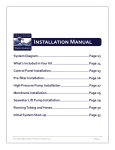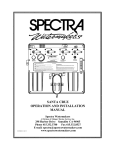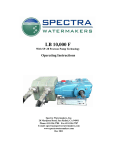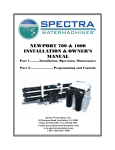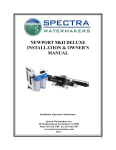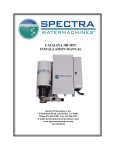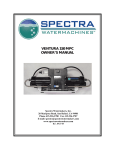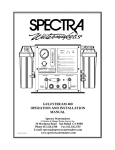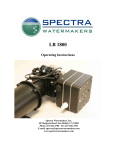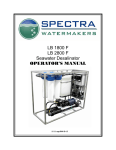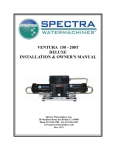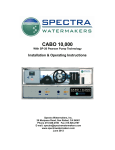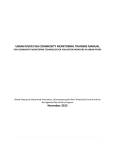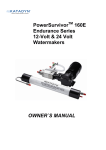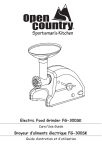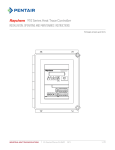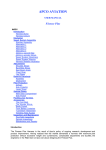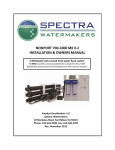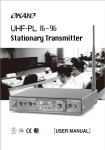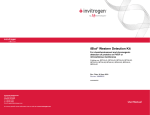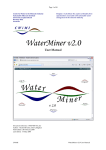Download Monterrey 1000 User Manual
Transcript
Monterey Installation Quick Start Important Details for Installer and Owner • It is imperative that the system have a dedicated sea water inlet to guarantee a solid flow of water to the system. The inlet should be as low in the boat as possible and a scoop type forward facing through hull fitting installed. Do not operate the system in rough conditions if the intake through hull is taking in air or damage may result. • Make sure to follow the wire gauge charts in the instructions. Using larger wire than specified is acceptable. • The MPC control must have DC power continuously to achieve the full benefits of the fresh water flush system. The domestic fresh water pressure must be on and the fresh water tank level maintained. If these operational conditions present a problem, consult factory. • The MPC control must be de-powered after the system is put in “storage” or “pickled” where a storage chemical or antifreeze is run through the system. • If you are remote mounting the membrane array, please follow the high pressure tube assembly instructions. These fittings must be tight! • Run test then “sea trial” the complete system before assuming the system is operational. If the boat is in fresh or dirty water see “Operation Procedures, New System Start Up and Testing”. • If you are a Spectra dealer we ask that you spend time with the vessels’ owner and operator so that they understand the operation and maintenance of the system. • Please have the owner fill out the warranty card. • Please read the Installation Instructions. page 1 MONTEREY 1000 OPERATION AND INSTALLATION MANUAL Spectra Watermakers Inc. 20 Mariposa Road, San Rafael CA 94901 Phone 415-526-2780 Fax 415-526-2787 E-mail: [email protected] www.spectrawatermakers.com 1/2/02 page 2 Introduction Thank you for choosing a Spectra Watermaker! It is our sincere wish for you to be completely satisfied with our product. We have inspected and tested all of the components before shipping and are confident we have produced one of the finest products available. Your long term satisfaction with this system will depend greatly on how the Spectra system is installed. The unique performance is obtained not only by our new pressurization process, but by careful attention to reducing flow restriction, mechanical friction and electrical resistance. All of this is affected by the final installation, and that is ultimately up to you. By reading, understanding, and following this manual, even if you are not doing the installation yourself, you will be completely satisfied with your new Spectra system. With years of experience installing and repairing many different kinds of watermakers, we have seen nearly everything that can happen to marine watermakers. This manual includes the summation of that knowledge, tailored for the Spectra Watermakers. Warning! It is very important to read and follow the instructions in this manual. Unsatisfactory performance, property damage, or personal injury may occur if the installation and operating procedures are not completely understood and executed properly. Caution! If someone else is installing the watermaker for you, review all aspects of the system with them before the installation begins. Pay special attention to how easy it will be for you to service the system. If you have any questions, please contact us. It is important the new system be checked by the owner/operator for proper installation, completely tested in seawater, and thoroughly understood before leaving on a cruise. Do not rely on the word of the installer that the system is fully operational. All watermakers will suffer damage if they are run then left to sit with salt water in them. The Spectra MPC 3000 controller can automatically fresh water flush after use and even re-flush every five days. Do not let the auto flush feature drain the fresh water tank. Damage to the fresh water pump may occur. The system can also be long term stored if necessary by flushing with a storage (pickling) solution. All the valves and plumbing necessary for servicing are included. In conclusion, having a reliable and adequate watermaker will improve the quality of life on board more than almost any other piece of equipment. This manual is designed help you take full advantage of your new Spectra Watermaker. You have indeed made the best choice! page 3 Table of Contents Shipping list page 5 Features page 6 Living With a Watermaker page 7 Component Description page 11 Clark Pump Diagram page 12 Operating Procedures page 15 Service Valve Position Photos page 18 DC Main Breaker & Manual Control Switches page 19 Long Term Storage page 20 Maintenance page 22 Membrane Cleaning Procedures page 23 Membrane Element Replacement page 25 Installation Instructions page 26 Installation Basics page 28 General Plumbing page 29 Component Placement page 31 Component Dimensions page 33 Clark Pump Mounting Diagram page 34 Monterey Plumbing Block Diagram page 35 Plumbing Connection Photo page 36 Monterey Plumbing Layout Diagram page 37 High Pressure Tube Assembly page 38 Parker Tube Assembly page 39 Electrical Component Placement and Wiring page 40 Feed Pump and Control Power Connections page 45 MPC 3000 Circuit Board Wiring page 46 Specifications page 47 Troubleshooting Procedures page 48 Warranty page 50 page 4 Shipping List Frame System (1) Operation and Installation Manual (1) Main Module Aluminum Frame including: Clark Pump Feed pump Membrane and Housing Array Automatic salinity control plumbing Automatic fresh water flush plumbing Flush pump 20 and 5 micron pre-filter assembly with pressure sensors Manual override controls (1) MPC 3000 Remote Control Panel including Wiring harness (1) Installation Kit Including: (10’) high pressure tube 50’ of 5/8” hose 25’ of 1/4” product tubing Hose and tube fittings Hose clamps One container of SC-1 storage chemical Hand held salinity monitor Modular System Same components without the aluminum frame Options Basic Cruise Kit Includes three 20-micron filters, three 5-micron filters, and two SC-1 storage chemical containers Offshore Kit Includes Clark pump seals, tools, two SC-2 and 2 SC-3 cleaning chemical containers, and overhaul instructions Spare Feed Pump Head Ultraviolet Product Sterilizer Additional Remote Panels page 5 Features The Spectra Monterey 1000 with the unique Spectra MPC 3000 automatic controller is the full featured flagship of the Spectra line. It is ideal for large sailing and motor yachts. Systems are available in modular or frame styles. Using the proven Clark Pump, the Spectra Monterey 1000 operates on a fresh water to power ratio that surpasses everything in the marine industry. The AC or DC current power draw is so low, a generator set is not always necessary. The system makes an average of 42 gallons per hour on less than 3/4 horse power, with about as much noise as a refrigerator. Operating pressures are selfregulating, eliminating the need for adjustments, even when operating in brackish waters. The Spectra MPC 3000 automatic controller is the most advanced marine watermaker control system available. The self regulating pressure feature of the Monterey allows it to be operated solely from the MPC 3000 remote panel even if the feed water changes from full sea water to even fresh water. Unlike conventional systems, no access to the system hardware for adjustments are necessary. Standard features include a salinity control system with product diversion valve, programmable automatic fresh water flush system, and readouts for operating conditions. It monitors all system parameters and will alarm if a fault is present and will stop the system if necessary. Operated in the Auto Mode, the MPC 3000 can be set for a desired run time then will automatically fresh water flush the system and re-flush every five says. The MPC 3000 controller is operated from the ships DC power supply, even on AC systems, allowing the system to operate in the auto re-flush mode without having to start a generator. The production of fresh water is stable through the system’s normal operating sea water temperature and salinity range. Only the working pressures change with the water conditions. A conventional 1000 gallon per day unit running in 61 degree F water will only make 700 gallons per day. The Spectra Monterey will still be producing 1000 gallons per day on a fraction of the power. The frame design allows for easy installation. All of the pumps, pre-filters, automatic systems, gauges, controls, and service valves are mounted in a lightweight frame. The system’s feed and flush pumps are self priming so they can be mounted up to 4 feet above the water line! A single self priming vane pump is all that drives the system. No additional boost pump is needed, or even helpful. A separate small DC driven prime/flush pump is used for the automatic flushing. A 20-micron and 5-micron dual pre-filter assembly is provided standard for maximum system life and reduced filter maintenance. The system’s noise level is exceptionally low and unobtrusive, as compared to other systems of similar capacity, and almost no vibration. page 6 Living With a Watermaker Now that you own a watermaker, what do you do with it? Making good drinkable water for sure, but there is more to it. You may not think it now but your watermaker will probably become a “mission critical” component for you. Like your engine, sails, and safety gear you will not want to go to sea without it. The following is to help you better understand the process of water making and making water reliably. Theory of Reverse Osmosis “Semi Permeable Membrane” You may remember that term from some science class. Each cell in our bodies is covered with one. It’s designed to be able to exchange desired chemicals in and out but reject unwanted ones. “Osmosis” (another science class term) is a phenomenon where a solution with a high concentration of “something” (lets say salt water) and a solution with a low concentration of the same dissolved “something” (fresh water) happen to be separated by a semi permeable membrane, a very strange thing happens. The fresh water wants to force itself through the membrane to dilute the salt water and the salt wants to migrate to fresh water side. “Osmotic pressure” is created by the fresh water forcing itself into the salt water side where there isn’t enough room for it. With sea water, osmotic pressure can build up to almost 400 pounds per square inch (psi). “Reverse Osmosis” (RO) happens when an artificial pressure, higher that the osmotic pressure, is applied to the sea water side. This will force fresh water back through the membrane. A little salt does go through but is highly diluted by the fresh water. There is a rub however. On the sea water side, as the fresh water passes through the membrane, the salts molecules crowd up against the membrane surface which starts to block the flow of fresh water. To stop this, a constant flow of new sea water must flow along the membrane surface to wash away the concentrating salts. So to have reverse osmosis we must have sea water flowing, at a pressure much higher than 400 psi, along the membrane surface. The spiral wound “thin film composite” membrane “element” that is in your pressure vessel was developed for this. The Modern Marine Reverse Osmosis Watermaker A water maker system must deliver a filtered high pressure flow of seawater through the membrane. That’s it. Some may have more bells and whistles than others but they all generate the high pressure flow. The trick is to do it efficiently, quietly, and reliably. Your Spectra system, with its 21st century Clark Pump technology, does it all. There are several things that can hamper a system, most caused by poor installation, and/or operator error and neglect. With the system set up properly, there has to be an unrestricted supply of seawater without air bubbles to the inlet of the system, the sea water must be filtered to 5 microns, the power wiring must be the right size with good connections, the system should be flushed with fresh water after use, if the system isn’t going to be used for a while it has to be properly stored or “pickled” to stop bio-fouling and/or freezing which will damage the membrane, and all service points placed in a convenient position. Installing Your Watermaker The installer must read the manual even if he or she has installed other Spectra systems. New information is constantly being added to our documentation. A lot comes from customer input. Pay special attention to the intake instructions, they must be followed. Even if you are not installing the watermaker yourself, read through the whole introduction and operation sections of the manual before starting. This will help you plan the layout of your watermaker.→ page 7 Living with a Watermaker cont. You are the one who will live with and service it; make it as easy as possible to take care if it. Caution! Watermakers contain high pressure salt water. A small leak can generate a water jet. Take care to prevent possible salt water damage to surrounding equipment or surfaces. Have the installer go over the complete system with you. Using a Watermaker A good watermaker is a significant investment but if used properly will pay for itself and more. First of all, make sure that it really is functioning properly before going to sea. A new installation should be thoroughly “sea trialed” in rough conditions at all points of sail or speeds to make sure the intake flow is OK. After that the system should always be run tested before leaving. A watermaker doesn’t like to sit idle with salt water in it. It wants to run. The best way to use it is to run it until the tanks are full then flush it. It can sit flushed for several days. Your fresh water usage pattern can typically adapt to allow for a watermaker run every 3 to 5 days on average. Use water! The water you make and how you use it is the payback on your investment. It’s hard to break old habits of water conservation on board but really try. Install a fresh water deck wash down system. By keeping the salts off the boat and gear, like you would in port after a day sail, the watermaker will pay for itself in less maintenance costs and resale value of the ship. By using more water for you and the crew, the quality of life on board is greatly enhance. One of the biggest benefits is the freedom it offers. It is easy to carry enough fuel and food to last a month or more but with a limited water supply the sailing itinerary is dictated by where you can get the next load of water. With an unlimited supply a whole new set of choices emerge. Once you get used to the benefits of a watermaker it is easy to think of it as a “mission critical” piece of equipment. But it is a complex system with several components subject to failure, though unlikely with proper maintenance. Always carry enough water to make it to your destination without the watermaker. The supply carried in reserve can be lessened as the passage goes to reduce weight but carry enough to get there. Have enough spare filters and storage/cleaning chemicals. Periodically check the system performance especially the electrical supply at the system under load. Electrical connections can go bad. This is especially true for high load and charging circuits. Inspect your charging system regularly. With the Spectra there is very little to wear out as long as the system is properly maintained. One of the most important components is the final 5 micron pre-filter. Do not scrimp there. If there is any doubt as to the condition of the filter element, replace it. It’s cheap insurance on your investment. Any filters in front of the 5 micron filter are not critical as they don’t have to be there for the system to work properly. Just the 5 micron has to be good. Filter elements are cleanable if they are cleaned before they start to resist the water flow. If the filters get really packed up don’t bother cleaning them as the particles have been pushed too far into the filter material. Get to know your system. Listen to all the different sounds it makes as it’s running normally. Literally put your ear on the Clark pump and listen to its heart beat. Get close to the feed pump and get to know it’s tone. Most problems with a watermaker have an associated change of sound. If you can notice subtle changes in it’s sound and feel, it can go along way to stop a small problem before it becomes a big problem. Fix any leak no matter how small right away especially if it’s coming from a metal fitting. If you can’t see it use your finger to feel for wetness. The extensive use of plastics and composites in the Spectra systems greatly reduce corrosion problems. page 8 Living with a Watermaker cont. Just a reminder. A watermaker system is bringing in a significant flow of seawater.→ The flow is well below the capacity of a typical bilge pump when working properly. A good test is to divert the full flow of the watermaker into the bilge and make sure your bilge pump system is up to the task. It doesn’t take much dirt in the bilge to completely stop a centrifugal bilge pump! RO Product Water. The water your system makes should be very good water. Most people want to know how good it is. A “Total Dissolved Solids” (TDS) meter reading in “parts per million” (ppm) is supplied with each system. Unfortunately reading errors can occur that may alarm you. Hand held meters must have a good battery and re-calibrated periodically. Built in ones have to have the probe cleaned and re-calibrated also. The basic problem with a TDS meter is it is reading the “total” impurities of the water your making. This total is dictated by the feed water you happen to be floating in. Salt is what you can taste the most. Other minerals might not have a taste at all but will affect the meter. Most of us have a higher quality, more discerning TDS meter in our taste buds. Product water readings below 500 ppm in standard sea water are considered OK by most peoples taste buds. The rule of thumb is if the water is tasting OK to you and your crew it is OK no mater what the meter reads. Product water quality will degrade slightly as the membrane ages. But whether it is producing 150 ppm or 450 ppm, it really doesn’t matter if it tastes good. Membranes rarely fail catastrophically but there are several circumstances that can degrade a membrane, such as poor maintenance, or exposure to oil and aggressive chemicals like chlorine. Most of the time a good cleaning will improve quality and production to a satisfactory level. If a poor membrane doesn’t respond to cleaning, don’t go straight to hauling water or putting your dream cruise on hold. A poor membrane usually will work fine if it processes brackish water. Make water into the largest container you have then flush the system with some of it. Put both the intake, brine, and product service hoses (see instructions) into the container and place all the service valves to the service position. You are now using the water in the container as the “ocean”. Start the system and let it run normally. Taste the product water, it should be good. Now it can be directed to the tank or drinking water bottles. The mini ocean will slowly drain from the container, what’s left getting saltier as it goes. When there is about 1/10th of the water left, switch the brine discharge back to the run position and dump it. Repeat this until you have enough water to get where you need to go. Don’t let a poor performing watermaker stop you. Where to Run Your Watermaker Ideally, a watermaker wants to run in the cleanest water possible. This is mostly for the life of the pre-filters. Running in turbid water typically doesn’t hurt the system especially if the run time is short. Many more problems are created by not testing a system because the boat was in a harbor with murky water than discovering a problem with the system 300 miles out to sea, down wind. A system must be tested in real seawater to prove anything. If the water you are in is so bad that divers are melting before they can finish cleaning your boat’s bottom, you can make you own sea water with aquarium salts in a bucket. All storage chemicals must be flushed from a system before it can be run from an “ocean” in a bucket. Many people use their system in areas like the Chesapeake where the water is murky and only have extra pre-filter maintenance to deal with; they've done so for years. If there is no other way to test the→ page 9 Living with a Watermaker cont. system until the boat is in open water, assume it’s not going to work and plan the your trip accordingly. Most of the time when a boat is being prepared for a cruise, several systems must be sea trialed so leave enough time in your plans for this. How to Store Your Watermaker This is one of the most confusing aspects of living with a watermaker. You can’t just turn it off and leave for a month or two without damaging it. You might hear stories from people who do just that all the time and their watermaker is “fine”. The strange thing is it might be true but for every one that gets away with it a hundred will eventually damage their systems. The fact is, membrane maintenance is a very inexact science. You can read all the different watermaker manuals and will get a different version of how to maintain a membrane in each one. All we can do is give you the benefit of our experience in this field with the hope that our version will give you the best performance with the least aggravation. With that said what you need to do is pretty simple once you become familiar with it. First, don’t let the system sit with salt water in it at all….ever. It has been a common belief that running a watermaker a couple of hours a day without flushing in between will maintain it. The reality is sometime different. Temperature and sea water variables may cause a slow degradation of the membrane. So why not flush it every time? Your Spectra system is set up to do this automatically if you like. Next, how long can you leave it flushed? To be conservative, we say up to 5 days. After that it depends. If the temperature is cool it could last much longer but if you already have bio-fouling in the membrane the 5 day interval may be the maximum no matter what. Now that you have decided to store or “pickle” your system-what does that mean? Just this; you remove the salt water and replace it with fresh water mixed with a chemical that will stop biological growth. In a little more detail, you flush the system, get some flush water in a bucket, add the chemical to the bucket, then mix the solution in the bucket with the flush water already in the system. There are “service” valves built into your system just for this. The instructions give the full details but the basic concept is simple. When To Clean the Membrane The rule of thumb is: if the system is performing 10% below what’s normal for the conditions and is not caused by an electrical or mechanical problem, clean the membrane. Keeping a log of the system performance really helps in making this decision. You look at operating pressure, water quality, power draw, and production rate. Higher than normal pressures for the conditions and/or degradation of water quality without a significant drop in feed and product flow rate are indicators. As mentioned earlier the membrane will slowly degrade over time so cleaning can bring some performance back but not all. Like a pre-filter, the idea is not to let a large build up of fouling occur before you try to clean the membrane which is hard or impossible to get off. On the other hand, cleaning itself is a bit hard on the membrane so you don’t want to do it more than you have to. Cleaning is similar to pickling except that you re-circulate the chemical longer and try to heat it if you can. Heating the cleaning chemical is something that has been largely ignored by the marine watermaker industry but is done routinely for commercial land based watermakers Heating the cleaning solution makes it work better just like with your laundry. If you can’t heat it, just give the chemical more time to do it’s job and hope for the best (this has been the standard practice in the marine industry for years). page 10 Component Description Note: The Monterey frame components are pre-plumbed and wired at the factory. All installation plumbing connections are inside the frame. Main power, control power, and remote panel wiring connections are made inside the power control module. The Membrane array, pre-filter assembly, and power control module may be removed and mounted remotely if necessary. Clark Pump This is the heart of the system. The Clark Pump uses two opposing cylinders and pistons that share a single rod through a center block. A reversing valve, controlled by a pilot valve actuated by the pistons, allows the cylinders to alternate between driving and pressurizing. Pressurization is achieved by the rod being driven into the other cylinder. As the rod enters the cylinder, it pushes the piston which circulates the water out through the membrane and back to the reversing valve. The valve directs the water back into the same cylinder behind the piston, creating a closed loop. The rod displaces water as it enters the cylinder, raising the pressure enough for reverse osmosis to occur in the membrane, thus fresh water equal to the volume of the rod is produced on every stroke. The driving cylinder has feed pressure pushing on the top of the piston which has ten times the surface area than the end of the rod. The water under the piston (brine) is discharged overboard. This gives the piston a 10-to-1 advantage over the rod, allowing it to drive the rod into the pressurizing cylinder. When the piston bottoms out on the center block, it actuates the pilot valve and the process is instantly reversed. High efficiency is achieved because there is no "back stroke," allowing one cylinder to always be under pressure. The speed of this process is determined by the water flow from the feed pump. The feed pump has a nearly constant flow rate at a given voltage so the production of fresh water is nearly constant, only the pressures change with changes in sea water temperature and salinity. (see "Membrane" section) A pressure relief valve is incorporated in the Clark Pump to depressurize the system for service. Product out Membrane Brine out Spool Pistons Reversing Valve Spool Driving Cylinder Pressure Cylinder Check Valves Rod Pistons Pilot Valve Function Diagram Pilot pins Pilot Spool Feed Pressure In page 11 → Component Description cont. End block B Valve block End block A High pressure inletn or Accumulator port Composite cylinder and base Alternate brine outlet port Pressure relief valve Center block High pressure outlet Stainless steel tube Cylinder ring Clark Pump End cap Front View End block A End block B Valve block Brine outlet port Composite cylinder and base Stroke sensor HP accumulator tank port or HP inlet port Center block Feed in Stainless steel tube Cylinder ring End Cap Clark Pump Back View → page 12 Component Description cont. Reverse Osmosis Membrane Elements and Pressure Vessel Array The “RO” membrane elements do the real work. An element is made from membrane and separating layers attached and wrapped around a center catch tube then encased in fiberglass. The ends of the windings are open, allowing water to freely pass through from end to end. An element is installed into a high pressure vessel that directs the pressurized salt water to flow through the element and lets the product (fresh) water that passes through the membrane escape from the center catch tube. Threaded ports are provided for hose connections in the end caps of the pressure housings. The Monterey uses three membranes plumbed in series. As high pressure salt water flows across the membrane layer, fresh water is forced through the membrane and lead by a capillary layer to the catch tube. The excess salt water flowing out of the membranes is saltier and is called “brine.” No salts are collected in the membranes. Membrane element function is affected by sea water temperature and salinity. The warmer or less salty the water, the easier it is for the fresh water to pass through the membrane material. This means that since the water production of the Spectra systems are nearly constant, warmer water lowers the operating pressures. The membranes are carefully sized to handle typical sea water temperatures and salinity, keeping the pressures within limits set by the membrane manufacturers. MPC 3000 System Control The Spectra MPC 3000 gives the operator complete control of the watermaker during normal operation through a remote touch pad control panel. Four power outputs are available for optional devices such as an ultra violet sterilizer, a Zeta Rod water pretreatment device, etc. Two inputs are available for optional tank full indicator float switches The system monitors and displays product flow, product salinity, feed pressure, pre-filter condition, and total hours. There are alarms for a stall condition, high and low voltage, high feed pressure, continuous high product salinity, pressure differential across the pre-filters, and power interruption. An intake line blockage sensor can be added. If service is needed or a fault occurs, audio and visual alarms will sound and the proper message will be displayed. The system will automatically shut down if needed. Power feed wires connect inside the enclosure. The control module is powered by the ships DC system. The feed pump may be a different voltage. The MPC circuit board is housed in a control box with three switches located on the cover. One is an emergency shut off. The other two directly power the feed pump and the flush pump for servicing the system as in pickling procedures, cleaning the membrane, or emergency override if the controller fails. For normal operation both pump switches must be on “AUTO”. Feed Pump The feed pump is an 120V or 240V AC or 24 volt DC driven self priming stainless steel vane type with an adjustable pressure bypass. The full bypass pressure is preset at 260 psi. Partial bypass begins at approximately 220 psi. The electronic high pressure cut out is set at 240 psi. → page 13 Component Description cont. Flush Pump A 12 or 24 volt DC powered flush pump is used to fresh water flush the system at shut down. It is also used to help the priming of the main feed pump at start up. The ships domestic fresh water pressure is connected to the flush pump. An adequate supply of pressurized fresh water must be maintained for the flush system to function. 20 and 5 Micron Dual Pre-filter Assembly The pre-filters do the essential job of cleaning the sea water before it gets to the Clark Pump and R.O. membranes. High quality replaceable pleated fiber filters are used. Filter maintenance is crucial to the efficiency and life of the system. Five micron filtered sea water is mandatory. Do not use sub-standard filters. The 20 micron filter is plumbed in front of the 5 micron to reduce filter maintenance. The system can be run on a single 5 micron pre-filter if necessary. The MPC 3000 monitors filter condition and will alarm when filter service is needed. Analog Feed Pressure Gauge The dial type feed pressure gauge mounted on the output of the feed pump is used for system trouble shooting. Higher than normal pressures indicates the need for pre-filter service or a system blockage. Service Valves The service valves are in the feed, brine discharge, and product lines to provide easy access for proper maintenance. The service hoses attach to the panel face (frame style) or to the service valves directly (modular systems) and are lead to a cleaning container. IMPORTANT: The intake and discharge service valves will close off all the ports if the levers are moved to the “Off” or middle position. The product service valve cannot close the ports when the lever is moved half way. This precludes the possibility of blocking the product flow and causing an over pressure condition that could burst the tube. Always verify the valves are in the proper position for the mode of operation desired before starting the system. page 14 Operating Procedures New System Start Up and Testing Caution! If possible, avoid running the system if the vessel is in contaminated water, such as in a harbor or canal. That said, we suggest that the system be fully run tested before leaving port. We think that is preferable the sacrifice a filter by running in turbid water rather than waiting to get offshore to discover a problem or deficiency in the installation. Another alternative is to test the system with an artificial ocean. Open the pressure relief and flush the system by running the fresh water flush cycle 6 times with the pressure relief valve open and again 5 times with the pressure relief valve closed and the product water diverted. This will flush the storage solution from the membrane. The system can now be run using a clean source of sea water in the cleaning container. Unchlorinated fresh water mixed with aquarium salt purchased from a pet store can be used. Use the intake, brine discharge, and product service hoses to recirculate the salt water from the container. First Check That: • • • • Thru- hull valve is open. See caution about feed water condition above. Power is on. If you have an AC system both the AC power and the DC control voltage to the unit needs to be on. Service valves are in the “run” position. See photos on page 18. Domestic fresh water pressure system must be on. Next: • • • • “OPEN PRESSURE RELIEF VALVE” is displayed on the remote panel Locate the Clark pump and the pressure relief valve. See drawing on page 12. Open the pressure relief valve one turn counter clockwise. Push the Start/Stop or Auto Run button to start the system. The control will prompt: “STARTING” then “PURGING STORAGE SOLOUTION”. Warning! A system is always purged or serviced with the pressure relief valve open. The control will go into an starting mode and the feed pump will start shortly after. The system should prime within 60-90 seconds. Check the strainer and the brine discharge for water flow. There should be no bubbles anywhere in the intake hoses and the feed pump should sound smooth after the prime. If the feed pump continues to sound rough find the reason before continuing. Then: Inspect for leaks. After 20 minutes the system will stop, “alarm” and prompt: “CLOSE PRESSURE RELIEF VALVE”. • Close the pressure relief valve on the Clark pump and restart the system in Auto Run or with the Start/Stop button (manual mode). The system will now start in a normal operating mode but will continue to divert the product for ten minutes. • Inspect for leaks again! The system is now operating under pressure → • page 15 Operating Procedures, cont. Note. If you must stop the purge sequence for any reason, the control will default back to the beginning of the current operating purge mode to protect your system. If you know it’s OK you can bypass the purge sequence and enable a normal start. Pressing both Auto Run and Start/Stop simultaneously anytime during the purge sequence will bypass the purge sequence and enable a normal start. Warning! Damage may occur if the purge sequence is bypassed and the membrane is pressurized with storage chemical in it. Caution! Do not assume the system is operational without a complete run test at sea, preferably in rough conditions. Normal start up using the Auto Run button • • Press Auto Run button once and the system will prime and run for 1 hour. The display reads "AUTO RUN MODE" then "STARTING" with a 30 second priming countdown timer. After the prime, the display reads "AUTO RUN MODE" with a countdown timer. An hour of run time is added, up to 12 hours, with each successive momentary press of the Auto Run button. An hour can be added at any time. The display shows the default readout unless there is an alarm condition. Successive presses of the Alarm/ Displ button will scroll through the displays starting with "GPH PRODUCT". Upon auto shut down by the timer or by the optional tank full float switches, the system will automatically fresh water flush and re-flush every five days. Pressing the Stop/Start button stops the system at any time with no flush sequence. Normal start up using the Start/Stop button. • Pressing the Start/Stop button will prime and start the system in a manual mode. Display defaults to the product gph meter. The system will continue running until stopped by pressing the Start/Stop again with no flush or by the optional tank full switches with a 1 time flush. Normal operation • For optimum performance, run the system as long as possible then flush. Never let the system sit with salt water in it. Never allow continuous air leaks in the intake. If prefilters are going to be cleaned, do so when the first bar shows in the filter condition bar graph. Normal shut down • • • If the system was started using the Auto Run button the system will shut off on its own when the selected run time is over and will auto flush and re-flush every 5 days Pressing the Start/Stop button at any time will shut off the system with no auto flush function. The optional tank full float switches will shut off the system from any mode. If the system was started by the Auto Run button the system will flush and then re-flush every 5 days. If the system was started by the Start/Stop button it will do a 1 time flush. The display reads "TANK(S) FULL. Once one of the tank full float switches open, the alarm and "TANK(S) FULL" display ceases on its own. → page 16 Operating Procedures, cont. Flushing Warning! Proper operator understanding of the Spectra flush system and the vessel’s fresh water system configuration is mandatory for extended automatic flush cycles. The flush cycle must not be allowed to drain all the fresh water from the vessel or damage to the vessel’s fresh water pump may occur. Adding a low pressure cutout switch on the vessel’s fresh water pump is recommended if the vessel is to be left unattended during the Spectra “re-flush every 5 days” program. • • • • • • • • Make sure that there is enough water in the fresh water supply system to supply the watermaker for more than the expected time of operation in the “re-flush every 5 days” mode. Make sure that the pressure water supply is on and will stay on during the flush mode. Make sure that the pressure relief valve is closed. It should be if the system was just used to make water. The auto flush may not operate if the valve is open The DC power for the MPC 3000 must remain on during the auto flush mode. Turning off the DC power will disable the auto flush function and damage may occur. Pressing the Auto Store button will engage a flush and then the every 5 day re-flush. The flush pump starts and the flush water solenoid opens for 3.5 minutes and then shuts down. The display reads "FLUSHING" with countdown timer" then "AUTO FLUSH EVERY 5 DAYS" when the flush is finished. Pressing and holding the Auto Store button for 3 seconds will engage a 1 time flush. The system flushes as described above but will not re-flush every 5 days. Display reads "FLUSHING" with countdown timer” then the default display when finished. Pressing the Start/Stop button will cancel the auto flush mode. Approximately 5 gallons of fresh water is used for flushing. Emergency Operation • • • • • • In the event of a MPC control failure, the system may be operated manually using the manual feed and flush pump switches on the MPC 3000 control box. In manual operation the salinity control system is inoperative. Product water is available through the product service valve. If length permits, the product tube to the tank may be removed from the diversion valve in the frame and connected to the product service valve’s service port. Always discard the product water for the first few minutes of operation. The initial product water from the system may not be potable. Taste the product water before sending to a tank. For manual start up, switch on the feed pump using the feed pump switch. Monitor the feed pressure gauge on the feed pump for proper feed pressure. Shut down the system immediately if the feed pressure is 240 psi or above and the Clark pump is not cycling. Shut down if air is continuously present in the intake line or the feed pump is excessively noisy. The automatic safety controls are disabled in manual mode. For manual flushing, switch on the flush pump using the flush pump switch. Make sure the system is taking in fresh water by checking for operation of the ships pressure pump. Run the flush pump a minimum of 4 minutes. page 17 Service Valves in Run Position Service Valves in Service Position with Hoses Attached page 18 page 19 Monterey DC Main Breaker, Emergency Stop & Manual Control Switches Long Term Storage Procedures Watermakers are best run continuously. When not in use, biological growth in the membrane is the leading cause of membrane fouling. A warm environment will cause more growth than a cold environment. The auto fresh water flush system will greatly reduce biological growth but will not stop it. The 5 day re-flush feature allows the system to be shut down without any service procedures for extended periods of time but it doesn’t replace performing a storage procedure for long periods of non-use. If an optional “Zeta Rod” is installed in the system, the 5 day re-flush will maintain the system as long as unchlorinated pressurized fresh water is provided. Storage Shutdown or "Pickling" If the system is to be left unused for more than 2 weeks, perform the following pickling procedure. The procedure introduces a chemical compound into the system that prevents biological growth. Do not allow the system to empty the water tanks; a good charcoal filter is mandatory. Charcoal filters last a maximum of 6 months once wetted. Warning! The Spectra SC-1 Storage compound is specially formulated to be used as a Spectra system preservative. Sodium bisulfite or metabisulfite should not be used as a preservative in the Spectra systems. Use of sodium bisulfite will attack materials used in the Spectra systems and void the warranty. Warning! The pressure relief valve on the Clark pump must be open for this procedure or membrane damage may result. Maximum pressure 50 psi! The SC-1 Storage Compound has to be mixed at a ratio of 2 Spectra containers to 6 gallons of fresh water to have the proper solution. An average of 4 gallons in a Monterey system. This water has to be included in the mixture. Caution! • • • • Avoid contact with skin, eyes, or lungs with the storage chemical. Make sure the system has already flushed itself. If unsure of the system status, start the flush cycle with the MPC control. Once flushed, attach the service hoses to the face of the unit and direct them to a clean, 3 gallon or larger, plastic or SS mixing container. Turn only the brine discharge service valve to the “Service” position. Re-start the flush cycle and allow two gallons to flow into the container then turn press the Start/Stop button. Do not use tap water or any water that might have chlorine in it. With the system flushed and unchlorinated fresh water in the container, thoroughly mix two containers of the SC-1 storage chemical into the mixing container. Warning! Recheck that the pressure relief valve is open or membrane damage may result. Turn all the “Service” valves to the service position. Start the main feed pump manually using the manual switch on the MPC control box.. Run for 10 minutes to completely mix up the storage solution. Light discoloring of the solution is acceptable. After 10 minutes, turn the brine discharge valve to the “Run” position. When the container is empty, shut off the system.→ page 20 Long Term Storage Procedures cont. • • • • Close the intake thru-hull and turn the intake service valve back to the “Run” position. Remove and clean the sea water strainer screen and pre-filters. Reassemble dry. Turn off the DC power to the system. Caution! This is important so the system will perform an automatic storage solution purge cycle when the system is returned to service. When returning the system to service after pickling,check that the intake thru-hull is open and the service valves are in the “Run” position and the charcoal flush filter is still good. Turn on the system power and follow the instructions for a new or pickled system start up. Winterizing, Warning! Use potable water antifreeze (propylene glycol). automotive antifreeze (ethylene glycol). Do not use • Hardware stores in areas with freezing winters carry potable water system antifreeze or it may be ordered directly from Spectra Watermakers Inc. • Follow the mixing instructions provided with the antifreeze. • Set up the domestic fresh water system so pressurized antifreeze is available to the Spectra flush system. • Open the pressure relief valve and start the auto flush and run until the antifreeze is visible in the pre-filters then stop the flush with the Start/Stop button. • Attach the intake service hose and move the intake service valve to “service” • Place the intake service hose into a container holding at least 3 gallons of antifreeze and manually start the system. Run the system until the antifreeze is gone then stop the system. If the intake hose up to the flush module is to be flushed, instead of using the intake service valve and hose, remove the intake hose from the intake through hull and place it in the container of antifreeze. • Disconnect all of the product line connectors and blow through the tubes to purge of fresh water. A portable air pressure tank, filled at the gas station, with a rubber tipped nozzle works well for this. • Close the intake thru-hull. • On returning to service, replace the charcoal flush filter. page 21 Maintenance The Seawater Strainer • The sea water strainer’s stainless steel element should be inspected, removed and cleaned as needed. Be careful to ensure that the thru-hull is closed before disassembly and the seal and element are in place on reassembly. Put the screen up to the light for inspection. When the system is put into storage, remove, rinse and reassemble dry to impede corrosion. Check frequently during operation. The Micron Pre-filters • • Service the pre-filters as soon as possible after the first pre-filter service alarm sounds. When the second alarm sounds the system will shut down to prevent damage. If cleaning and reusing filter elements, clean when the first bar on the filter condition display comes on. The easiest way to service the filters is to first shut off the thru-hull, open the housings, discard the old filters, remove the O-rings to avoid loosing them, and clean the housings. Reinstall the O-rings and reassemble the pre-filters with new 20 and 5-micron filter elements. The 5-micron filter goes down stream from the 20-micron. Leave dry until the next start-up. Used pleated elements can be carefully cleaned if they are not too compacted. Do not use full pressure from a garden hose or scrub with a hard brush on the pleats. Gently spray the outside with water and then plug one end with your hand, filling from the other end to flush from the inside. Be careful to not distort the pleats. Another way is to tow them behind the boat until clean, 4 knots maximum. Slip a line through the filter and tie a stopper knot. Elements that show any signs of deterioration, especially the 5micron, should be replaced. Check for leaks on the first run after a filter service. The Charcoal Fresh Water Flush Filter • Replace the charcoal filter element at least every 6 months. The Membranes • • The membranes need to be cleaned only when they have lost up to 10% of their capacity due to fouling or the product quality degrades. The leading cause of fouling is from biological growth that occurs when the system is left unused without flushing or pickling. Fouling from mineral scaling can happen during operation under certain sea water conditions, and from rust. Monitor the product salinity bar graph for a higher than normal readings and the feed pressure gauge on the feed pump for higher than normal pressures for the conditions. Other conditions can cause high pressure such as cold feed water or clogged pre-filters. Low product flow is usually due to low voltage, poor feed pump, clogged pre-filter, or a damaged Clark pump. Look for all other causes before cleaning the membrane. There are two types of cleaners; acid and alkaline. The acid cleaner (SC-3) will remove mineral scaling. The alkaline cleaner (SC-2) is used to remove biological by-products, oil, and dirt particles that get past the pre-filters. If membrane performance is reduced and has not been pickled recently, cleaning with both chemicals is recommended. The acid cleaner should be used first. If the membrane fails to respond to both cleanings, this is an indication of another problem with the system, or that it is time to replace the membrane. Contact Spectra Watermakers before removing a membrane. page 22 Membrane Cleaning Procedures For normal cleaning, the SC-3 Acid Cleaning Compound is used first, then the SC-2 Alkaline Cleaning Compound. If known bio-fouling is present, the SC-2 may be used first. Using hot water if possible, 120º, is highly recommended as it greatly enhances the ability of the cleaners to do there jobs. If the history of the system is unknown or has been left “unpickled” for an extended length of time and biological growth is present, it is recommended that the system is cleaned with the SC-2, using an alternate source of unchlorinated fresh water before the system is run under pressure. A simple test can be performed to see if biological growth has occurred: Before running the system, remove the pre-filters and examine their condition. If the housings are full of discolored smelly water, the system was not properly stored. Install clean pre-filters if they were bad. Next check the membrane. Attach the brine discharge service hose and lead to a container. Open the pressure relief valve 1 turn and turn the brine discharge service valve to the “Service” position. Manually run the system for 30 seconds. Examine the brine water; if it’s discolored and smells bad, perform a SC-2 cleaning with an alternate source of unchlorinated water before running the system pressurized. If the brine is fairly clean, the system can be purged, run normally, and checked for performance. Clean the membranes only if performance is reduced. Heating the water is preferable. One way to do this is find a camp stove and use a large SS pot to heat the cleaning solution in. The cleaning solution throughout the system will heat as it circulates in and out of the pot. An alternative is to heat the one or two gallons of initial water in the cleaning container to 120° F on the main stove before mixing in the cleaner and circulating it into the system. Periodically stop and reheat the solution. Perform the cleaning procedures while the ship is in acceptable sea water for purging and testing. Cleaning Procedures Note: procedures are the same for the SC-3 and SC-2 cleaners A Spectra Cleaning Compound (SC-2 or SC-3) must be mixed with fresh water at a ratio of 2 Spectra containers to 6 gallons to have the proper solution. An average of 4 gallons are in a Monterey system. This water has to be figured in the mixture. SC-3 and SC2 are never mixed together. Do not use them for storage. Warning! The pressure relief valve on the Clark pump must be open for this procedure or membrane damage may result. Maximum pressure 50 psi! Note: Triple the run/soak times if the solution is not heated • Attach the service hoses to the pump/valve module and direct them to the cleaning container. Make sure the domestic water pressure system is on then start the automatic flush system. When the flush cycle stops, move only the brine discharge to the “Service” position and restart the flush cycle. Allow two gallons of flush water to flow into the container, then stop the system with the Start/Stop button. Do not use tap water or chlorinated water! Distilled or charcoal filtered water is acceptable if using the flush water is not an option. Start heating the water. → page 23 Membrane Cleaning Procedures cont. • With the system flushed and unchlorinated fresh water in the container, thoroughly mix two containers of the chosen cleaning chemical into the mixing container. Warning! Re-check that the pressure relief valve is open or membrane damage may result. Turn all the “Service” valves to the service position. Start the main feed pump manually using the manual switch on the MPC control box. Do not use the remote control panel. • Run the system unpressurized for one hour while maintaining the solution at 120º F, then turn off for one hour to let the membrane soak. Don’t forget to turn off the stove. Run the system again for 1 hour while heating the solution, then turn off for one hour. Do not let the water get above 120º F! Triple the run soak times if the water is not heated. • Turn the brine discharge service valve to the “Run” position. Restart the system, the solution will now drain from the container. • Place the intake service valve to the “Run” position. Run the system unpressurized on sea water for at least 30 minutes to purge the cleaning solution. • After purging, close the pressure relief valve to pressurize the system. Manually divert the product water with the product service valve into the cleaning container. After 30 minutes, check the feed pressure, product flow, and quality, to determine if the membrane is functioning normally. If the cleaning solution became very discolored during the cleaning process, it is recommended to repeat the process. If the first cleaning did not affect the membrane enough, repeat the cleaning process using the other cleaner. Always manually reject the product water for 30 minutes after cleaning. • If the membrane performance is still poor and no other problem can be found, contact Spectra Watermakers for further assistance. page 24 Membrane Element Replacement Do not remove the membrane from the housing unless absolutely necessary. Troubleshoot for all other causes of poor performance and try the recommend procedures first. Caution: membranes must be stored wet with preservative to prevent permanent damage. Disassembly: • Remove and move the membrane housing array to a work area that can handle water spillage. Hold the body of the SS tube fittings when loosening the nuts. Clean off any deposits on the ends with a stiff brush and fresh water. Note which ends go where so they can be reinstalled the same way later. • There are two ways that the membranes can be replaced; with the housing still in the clamps or with the housings separated. • With the housings still in the clamps, loosen the ring on the array inlet end cap with a strap wrench or use a hard plastic or wood punch and a mallet on the slot provided. As the retainer rings unscrew, twist and pull the end cap to follow the ring out. You will feel the O-ring come out of the housing before the ring is off. Do the same for the outlet end cap of the array. Remove the interconnects before removing the rest of the end caps. Inspect the end plugs and O-rings for damage, replace if necessary. • Push the membranes elements out of the housings by first pushing on the outlet ends. If they resists, try pushing on the other end. If a membrane is going to be kept for any reason, seal it in plastic before it dries out. Do not open the new membrane packaging until ready to install. • To separate the housings first remove the end cap interconnects. Loosen the bolts holding the plastic clamp haves together and remove the top clamps. The tubes are now free. Assembly: • • • Check that the new elements have brine seals on one end only and the seals are oriented the same way as the old membranes. The seal lip should point outwards. Lubricate the element brine seal and wet the whole inside of the housing. Install a membrane, starting at the outlet end of the housing, by inserting the brine seal end first. Use your fingers to compress the lip of the seal to get it started without folding over. Push the membrane all the way into the housing so the brine seal is now at the inlet end of the housing. Reinstall the ends and housings in reverse of the way they were disassembled. Lube the cap O-rings and the housings with a very thin coating of silicone grease or soap and water. Thread the end caps on until the o-rings touch the housing. Check that everything is straight and then continue to tighten the rings until they stop. Leave the rings just loose so the end caps can be rotated for tube and interconnect assembly. After the housing are assembled in the clamps, reinstall the interconnect tubes. Tighten the retainer rings after the whole assembly is assembled. Do not over tighten the rings. New membranes have a pickling solution and should be thoroughly flushed before use. Follow the new system start up procedures. Look for leaks at the end plugs. If a large leak is present, the large O-ring around the end plug is not seated properly and the end plug will have to be removed and redone. A small leak at the tiny vent port by the SS fittings indicates a missing or damaged product tube O-rings inside the end cap. page 25 Installation Instructions Please follow the instructions carefully. Any deviation from the following procedures must be approved in writing by Spectra Watermakers or the warranty may be voided. Spectra Watermakers are a new generation of marine watermakers with important differences from older designs. Shopping List Materials needed in addition to the installation kit. Refer to manual for wire size, fuses or circuit breakers, and type of fasteners • • • • Fasteners/Hardware for mounting components to desired surfaces. Marine grade wire, connectors and wire ties with mounts. 3 gallon minimum stainless steel or plastic mixing container. Fuses for AC and DC power connections Tools Required • • • • • • • • • Wrench set to 7/8” Adjustable wrench 3/8” drill, drill index and a hole saw set Jig saw or coping saw Screwdrivers 5/16” nut driver for hose clamps (not needed but helpful) Wire cutter Wire stripper Electrical crimping tool for insulated connectors page 26 Monterey Installation Quick Start Important Details for Installer and Owner • It is imperative that the system have a dedicated sea water inlet to guarantee a solid flow of water to the system. The inlet should be as low in the boat as possible and a scoop type forward facing through hull fitting installed. Do not operate the system in rough conditions if the intake through hull is taking in air or damage may result. • Make sure to follow the wire gauge charts in the instructions. Using larger wire than specified is acceptable. • The MPC control must have DC power continuously to achive the full benefits of the fresh water flush system. The domestic fresh water pressure must be on and the fresh water tank level maintained. If these operational conditions present a problem, consult factory. • The MPC control must be de-powered after the system is put in “storage” or “pickled” where a storage chemical or antifreeze is run through the system. • If you are remote mounting the membrane array, please follow the high pressure tube assembly instructions. These fittings must be tight! • Run test then “sea trial” the complete system before assuming the system is operational. If the boat is in fresh or dirty water see “Operation Procedures, New System Start Up and Testing”. • If you are a Spectra dealer we ask that you spend time with the vessels’ owner and operator so that they understand the operation and maintenance of the system. • Please have the owner fill out the warranty card. page 27 Installation Basics The Spectra Watermakers are designed for energy efficiency. All aspects of the system have been optimized for this goal, therefore any changes in the basic layout or components will most likely reduce this efficiency. The overall length of the feed, discharge and high pressure hoses have little effect on performance but every hose bend or 90 degree fitting absorbs power. Avoid adding 90 degree fittings. Use gentle hose bends where possable. A good installation will be a proper compromise between minimum hose and wire runs, accessibility, environment and esthetics. Thru-hulls • • • • • It is recommended that a designated 3/4” to 1” intake thru-hull and seacock be installed for the system as far below the water line as possible. A protruding scoop type is mandatory. Thru-hulls in the bow area are susceptible to air intake in rough conditions. Sharing a thru-hull with another system is unacceptable and will void the warranty. Sharing a thru-hull can introduce unforeseen problems such as intermittent flow restriction, air bubbles and contaminates. For racing boats a retractable snorkel type thru-hull fitting is preferred to be able to pick up water away from the hull. Do not install the intake close to or down stream of a head discharge. Install as far below the water line and as close to center line as possible to avoid contamination and air induction. We recommend that a reputable boatyard install any underwater thru-hulls. The discharge thru-hull should be mounted above the waterline, in or just above the boot stripe to minimize water lift. Having the discharge feed into a cockpit or sink drain will work, but can make an unpleasant gurgle sound. Double clamp all hose connections below the water line. Pipe Fitting Instruction • • • • • Metal pipe fittings that are to thread into plastic should be coated with at least 3 wraps of Teflon tape. To avoid cracking the plastic, tighten until only 1/2 to 2/3 of the threads are buried. This may not seem tight, but they will not, and should not, bottom out like a metal to metal connection. Do not thread them in all the way. Metal to metal pipe connections should have 1-1/2 to 2 Teflon wraps only. Plastic to plastic fittings should have 3 to 4 wraps and will thread almost all the way in. Be very careful to avoid getting any tape over the end of the fitting that might get into the system. To insure this does not happen, leave the very first thread uncoated. Male pipe/tube fittings with an O-ring under the body nut use 1-1/2 wraps of tape and thread into specially machined threaded ports until the nut just contacts the surface, burying the O-ring. The membrane end caps and the Clark pump cylinder end caps are machined for O-ring pipe fittings. page 28 General Plumbing Several types of hose and tubing are incorporated into the Spectra systems to meet specific needs. Care must be taken to use the proper type for each section of the plumbing system. For a modular system, the 90 degree high pressure SS tube fitting mounted in the high pressure out on the Clark Pump can be rotated up to 1/2 turn for better tube runs. The high pressure inlet fitting and the SS accumulator tank can be swapped for better tube runs. Double clamp all connections that are below the water line on the suction line to the feed pump. Re-tighten all hose clamps and check for leaks after the first few hours of running. Use straight hose fittings and gentle turns in the hose where possible. Minimum hose bend radius is 6”. Tightly secure hoses with tie wraps to avoid chafe. Suction Hose • • This is 3/4" wire reinforced clear nylon. Route the hose smoothly from the intake thruhull, to the strainer, then the intake service valve. This hose is designed for suction. Do not use it in a pressure application. The web re-enforced 3/4” hose that can handle the flush pressure is used between the check valve, flush water inlet tee, and the intake of the feed pump. In a modular installation, keep this section as short as possible without any sharp bends. Warning! Any air leak in the intake plumbing will damage the feed pump. Feed Pressure Tube • • This is pre-plumbed in the main module. 1/2” Parker tubing and fittings are used between the feed pump, pre-filters, and the Clark pump. To handle feed pressure up to 260 psi, proper assembly of the fittings is critical. See tube fitting assembly instructions. High Pressure Tubes • • • • For remote mounting of the membrane array, be sure to follow the Clark Pump and Plumbing Diagrams for proper connection between the Clark Pump and the membranes. Membrane water flow direction is marked on the housings. Rotate the 90 degree high pressure tube fittings on the Clark Pump up to 1/2 turn for ideal tube runs. The high pressure tubes are usually made in place. Loosely route the tubes between the Clark pump and the membrane and cut long. Minimum tube bend radius is 6”. Follow the high pressure tube connection instructions. Connect the tubes to one of the components, secure the tube runs, and then trim and connect to the other component. A 90 degree bend in a hose is better than a 90 degree fitting. A tube, when mounted, should have at least one gentle bend to allow for expansion. Do not connect a tube straight between hard mounted fittings. When connecting the tubes to the components, be sure to hold fitting body during the final tightening. If other than the Spectra supplied high pressure tube and fittings are used, they need to be at least 1/2" ID if hose, 1/2” OD if tube, with non-ferrous 1/2” high pressure fitting,s and have a working pressure of at least 2000 psi. → page 29 General Plumbing, cont. Product Water Tubing • The product water lines are 1/4” Parker tubing from each membrane to a collector then 3/8" Parker tubing to the system and tank. Minimum tube bend radius is 4 inches. Connections can be made to either end of the membrane housing. Refer to the tube fitting assembly diagram. • Caution! The product water flow should not be restricted in any way. If the line gets blocked, the pressure will build until the line fails. Restricting the flow will reduce efficiency and may cause damage to the membrane. Connect to the water tank at or near the top. The ideal spots are to tee into the tank vent line or the fill hose. Do not tap into the bottom of the tank or a water feed manifold. Air can be pulled through the membrane and affect the domestic water system. Connect the tank line to the product diversion valve inside the Frame. See plumbing connection photo. Leave enough length in the tank line so it can be removed from the diversion valve and attached to the product service valve, on the face of the unit, for emergency operation. • • • • page 30 Component Placement Refer to the Dimension & Plumbing Diagrams Main Pump and Control Frame Module The main pump module is designed to mount on a horizontal surface that can be up to 4’ above the waterline. • Locate in an area that allows easy access to the face panel and the service hoses can reach a container placed in a spot where water spillage is acceptable. • Allow for a minimum of 2” of clearance on the sides and 12” over the top, and at least 1” of clearance at the back. Extra space over the top is preferred for easier internal access. • Use the unit itself as a template for drilling the mounting bolt holes. Use quarter inch bolts or lag screws with washers. If lag bolts are used they must thread into at least 1” of solid material. Drill pilot holes for lags bolts. • Clark Pump (modular systems) • • • • • • • Refer to the Clark Pump Mounting Diagram. Bolt the mounting brackets to the base of the center block with the short 5/16” SS bolts and washers, sandwiching the plastic washers in between the center block and the brackets. The brackets will over hang from the front and back of the center block. Moisten the rubber shock mounts and slip them into the bracket holes then install the plastic inserts. The Clark Pump can be mounted on any horizontal surface that will support it’s weight and is not subjected to excessive vibration. Height above or below the water line is unrestricted. Mounting on a vertical surface can be expedited by using the optional "L" mount bracket. For hanging from overhead, use two of the "L" brackets. Avoid mounting in the middle of a large unsupported flat surface that could amplify the sound of the pump shift. The Clark Pump can be mounted in any position if it is hard mounted without using the brackets. More noise may be transferred to the vessel. Allow room in the front and back for access to the high pressure tubes and hose connections. If the space behind the unit is restricted, attach the high pressure tubes to the Clark Pump before final mounting. The 90 degree fittings supplied are acceptable for the feed and high pressure tube connections to the unit and can be rotated up to 1/2 turn for easy tube runs. Straight fittings can also be used. The brine discharge hose connection to the reversing valve body should be straight if possible, and can be connected to either end of the reversing valve. Plug the unused port. Make sure that the area around and under the pump does not have any water sensitive equipment. Water will be spilled during any repairs or if a leak occurs. Use the Clark Pump mounting hole guide to layout and drill for the fasteners. 1/4" bolts and Nylock nuts are preferred, but lag bolts are acceptable if they penetrate at least 1" into solid material. Drill pilot holes for lags bolts. Caution: Tighten the fasteners until there is light pressure on the plastic inserts. The plastic inserts will collapse if over tightened. The 1/4” fender washer must be on top to prevent the mounting brackets from slipping out of the rubber mounts under adverse conditions. Do not mount the Clark Pump in an area that is subject to sustained temperatures over 120 degrees F. → page 31 Component Placement, cont. Membrane Array Mounting • • • • • If the membranes are to be removed from the Monterey frame, mount the membrane and housing array near the system as close to the frame and in as cool a place as possible. Mount the array using the four angle mounts. The membrane housings are marked for water flow direction and can be mounted at an angle or vertical, but the brine outlet end should be up to help purge air. Route the high pressure tubing to and from the membrane housing as smoothly as possible. Avoid clamping the tubes tightly to any surfaces for sound dampening. "Hanging" the tubes away from a surface with wire ties so that they are neither tight nor completely loose is best. Follow the high pressure tube fitting instructions on page 36. The product water collector can be connected to either end of the array. Plug the unused product ports and re-label. Do not mount the membranes in an area that is subject to sustained temperatures over 120 degrees F. Remote Control Panel • • • • The remote control panel can be mounted anywhere that’s dry and convenient. Cut a 4-9/16” wide by 2-7/8” high opening for the panel If the mounting area is finished wood, tape the outside perimeter of the cutout and use a reverse tooth saw blade to prevent splintering. Carefully run the remote cable between the panel and the main pump module. Connect to one of the “display” sockets on the main circuit board inside the control module. If access to the back of the panel is limited, leave enough cable to be able to take the panel off for servicing. Fold the extra cable back through the cut-out and secure the panel with # 4 screws. Do not use non Spectra remote control cable. The cable is not standard LAN cable. There are terminals for an alarm buzzer on the back of the remote panel. Caution! Do not apply power to these terminals. Fresh Water Flush Pump • • • • For remote mounting, mount the flush pump close to the intake line for the feed pump ideally. The pump inlet is connected to the ships pressure water supply. The flush pump can be mounted vertical with the pump head down or horizontal. The flush pump output connects to tee in the saltwater feed line as close to feed pump as possible. The check valve must be install in the saltwater feed line upstream of where the flush pump tees into the feed line. Strainer • • Mount the strainer close to the intake thru-hull in an accessible area that can handle water spillage during service. Extra care during assembly must be taken to avoid air leaks from the strainer while the system is running. Air in the intake will damage the feed pump. page 32 15.0" 25.0" 43.5" page 33 31.9" SPECTRA Sausalito, California Phone (415) 332-3780 Fax (415) 332-8527 spectrawatermakers.com 27.0" Spectra Monterey Components Dimensions Drill for 1/4" bolts, 1/4" lags, # 14 SM Screws 6.500" Clark Pump Mounting Hole Layout Under Cylinder Under Cylinder 4.000" Back IMPORTANT! Not a Template Front Lag or screw mounting Bolt mounting 1/4" SS Bolt 2"-1/4" SS Lag bolt or # 14 sheet metal screw Caution: Do not over tighten, the plastic inserts may crush. 1/4" SS Fender Washer Plastic Insert Rubber Grommet Center Block 1/4" SS Fender Washer Plastic Insert Plastic washers Rubber Grommet 5/16"-3/4" Mount Bolts Pre-Drill Mounting Surface Plastic washers Bottom view Aluminum brackets Note: Remove alluminum mounts before shipping the Clark Pump. Clark Pump Mounting Modular Systems page 34 Pressurized fresh water from domestic water system to Shurflo flush pump 3/8" product tube Tank fill SPECTRA Sausalito, California Phone (415) 332-3780 Fax (415) 332-8527 www.spectrawatermakers.com Monterey 3500 Fresh water tank Charcoal filter page 35 Brine discharge Removable service hoses Intake Strainer Cleaning container Monterey Plumbing Block Diagram page 36 High pressure outlet Membrane Array Product out High pressure inlet 1/2" H.P. tube to top H.P. inlet 1/2" H.P. tube from bottom H.P. outlet 3/8" Parker tubing Product service valve Brine outlet 5/8" hose Salinity control Clark pump 1/2" Parker tubing Check valve Brine discharge service valve Tank fill 20 micron 5 micron Pre-filters Fresh water tank Web reinforced 3/4" hose Intake service valve Check valve Flush solenoid valve Wire reinforced 3/4" intake hose Cleaning contaner Feed pump Charcoal filter WARNING! Only use Spectra approved hose and tubing 3/8" Parker tubing Brine discharge Intake strainer Flush pump Intake Pressurized fresh water inlet 1/2" hose barb standard Monterey 1000 Plumbing Diagram page 37 Spectra High Pressure Tube Fitting Assembly Carefully fit and measure the tubing before cutting with a sharp razor knife or hose cutter and remove any burrs. Minimum tubing bend radius is 6”. Route tubing away from excessive heat sources and secure from vibration and chafe. Have at least one shallow bend in a tube assembly after it is installed. Refer to figure 1. If a fitting has been dissembled, reassemble as illustrated. The notch on the ferrule must engage the inside of the nut properly for the nut to seat down fully. Once the tube is inserted, the ferrule and nut will naturally align. Refer to figure 2. Insert tube fully into the fitting, it should go in 0.9”. Tighten the nut finger tight while moving the tube around to prevent binding. One thread should be showing under the nut. Secure the tube so it won’t back out when tightening. Refer to figure 3. Use 13/16” wrench to hold a straight body fitting or a 3/4” wrench for a 90º body, and a 7/8” wrench for the nut. Hold the body, recheck the tube insertion, then tighten the nut 1-2/3 turns (10 flats) after a good finger tight. Use the index mark on the nut as a guide. The threads should be completely covered by the nut. The tube connectors can be disconnected and re-tighten several times. To reconnect, insert the tube and ferrule into the body then hand tighten the nut. Hold the body and tighten the nut with a wrench a little past where resistance is encountered. When correct, the nut should be tightened a little past where it was before disassembly. Always check for leaks. Index mark Straight thread Pipe thread Figure 1. Ferrule Nut Body Cut tube square Figure 2. Black high pressure tubing Tighten 1 2/3 turns (10 flats) with a 7/8" wrench after finger tight. Use index mark as guide Figure 3. No threads showing Important! Insert tube 0.9" until it stops page 38 Body Step 1: O-ring Single grab ring for 3/8" Double grab rings for 1/2" Spacer Nut Tabs Dissemble fitting components 7/16" max Step 2: Slide nut, grab ring(s), spacer, and O-ring onto the end of the tube. Push on the O-ring to slide the grab ring(s) and spacer back so the O-ring is 7'16" max 3/8" min. from the end of the tube. Grab ring(s) must be tight on the tube. If not, bend the tabs in to reduce the I.D. of the ring. Step 3: Gently fit the tube into the body and loosely thread on the nut. Be careful to not cross thread the nut. 1/2" tube should not bottom out in the fitting to allow full compression of the O-ring Step 4: Hand tighten the nut. DO NOT OVER TIGHTEN! DO NOT USE A WRENCH! The tube should not come out if pulled by hand. If it does, tighten the grab ring tabs. 3/8" & 1/2" Parker Tube Fitting Assembly page 39 Tubing Electrical Component Placement and Wiring Guidelines General • • On DC only powered systems, the power for feed pump and the MPC controller is shared and pre-wired inside the Power Control Box. On AC systems, power for the MPC controller is supplied from a separate 12 or 24 volt source and wired directly to the circuit board. Warning! Do not connect AC or DC power to the control box until after all wiring connections are finished including remote panel connections. Power Control Box • • • • If mounted remotely, the control box must be mounted vertically on a bulkhead, away from spray or dripping water. The DC supply circuit must be rated to support a 20 amp continuous load for 12 volt systems, or 10 amps continuous for 24 volt systems. The AC supply circuit must be rated to support a 15 amp continuous load for 110 volt systems, or 7.5 amps for 220 volt systems. Use LARGE gauge feed wire rated as follows to avoid a voltage drop and related loss of performance. Note: Wire length in feet is measured from source circuit breaker to control box and back to source [total length of supply wires] 12 volt DC feed wire size for the MPC controller on AC systems WIRE LENGTH AWG wire size Square MM wire size To 20 feet 20 feet to 30 feet 30 feet to 40 feet 40 feet to 50 feet 50 feet to 60 feet 10 awg 8 awg 6 awg 4 awg 2 awg 5 sq mm 8 sq mm 13 sq mm 19 sq mm 32 sq mm 24 volt DC feed wire size for the MPC controller on AC systems WIRE LENGTH AWG wire size Square MM wire size To 20 feet 20 feet to 30 feet 30 feet to 40 feet 40 feet to 50 feet 50 feet to 60 feet 12 awg 10 awg 8 awg 6 awg 4 awg 3 sq mm 5 sq mm 8 sq mm 13 sq mm 19 sq mm page 40 → Electrical cont. 120 volt AC system feed pump wiring WIRE LENGTH AWG wire size Square MM wire size To 25 feet 25 feet to 50 feet 50 feet to 75 feet 12 awg 10 awg 8 awg 3 sq mm 5 sq mm 8 sq mm 240 volt AC system feed pump wiring WIRE LENGTH AWG wire size Square MM wire size To 25 feet 25 feet to 50 feet 50 feet to 75 feet 14 awg 12 awg 10 awg 2 sq mm 3 sq mm 5 sq mm 24 volt DC feed pump and controller systems WIRE LENGTH AWG wire size Square MM wire size To 20 feet 20 feet to 30 feet 30 feet to 40 feet 40 feet to 50 feet 50 feet to 60 feet 12 awg 10 awg 8 awg 6 awg 4 awg 3 sq mm 5 sq mm 8 sq mm 13 sq mm 19 sq mm • • • For large wires, it may be advisable to use a terminal block or distribution posts near the control box to terminate the large cables then run smaller cables to the power inlet studs on the circuit board. The wire leads for the stoke sensor, and the pressure sensors, are 6ft [2M] long. The control box must be located so that the wire leads can reach the sensors. If the wire leads for the sensors must be extended, see details below for proper wiring procedures. The control box has three switches located on the cover. One is an emergency shut off. The other two directly power the feed pump and the flush pump for servicing the system as in pickling procedures, cleaning the membrane, or emergency override if the controller fails. For normal operation both pump switches must be on “AUTO”. Remote Control Display Panel(s) • • The system can accommodate up to 3 remote control display panels. The displays must be mounted in a protected location, out of direct sunlight, and away from spray or dripping water. Commands can be entered at any panel. The display panels connect with the supplied 50 foot modular-type cable to the control box sockets marked “DISPLAYS” on the MPC circuit board. Do not substitute a different type of cable! If you need longer cables contact the factory. → page 41 Electrical cont. • • • Use care when pulling the modular cable through the ships’ wiring harness as the end plugs are easily damaged by excessive force. Fold back 4” of wire and tape over the end plugs before pulling the cable to prevent damage. If the cables are damaged during installation, the system will not operate and the controller may also be damaged. If in doubt, use a new cable. Each remote control display panel can accommodate an external alarm buzzer to provide audible alerts in the event of a fault or at the end of certain timed cycles. Use only the buzzer units supplied by Spectra Watermakers, as current on the buzzer circuit is limited to 20 milliamps, any excessive load may damage the controller or remote display panel. Connect the buzzer RED wire to the terminal marked +POSITIVE, connect the buzzer BLACK wire to the terminal marked – NEGATIVE on the back of the remote display panel. Caution! Do not connect power to these terminals. A buzzer may also be installed at the control box. See accessories, below. Feed Pump Wiring • • • • The feed pump wires connect to a power relay or solenoid inside the Power Control Box. The terminals are marked. The relay/solenoid is controlled by “PMP 1 / GND” output on the MPC circuit board. Follow the proper AC or DC wire size table if the pump is mounted remotely from the Power Control Box. If a DC powered cooling fan is used, it can also be connected to “PMP 1 / GND” on the circuit board. Use heat shrink tubing on all connections made outside of the control box. Fresh Water Flush Pump Wiring • • The fresh water flush pump connects to “PMP 2 / GND” on the MPC circuit board. Follow the proper DC wire length table for the pump voltage. Pressure Sensors • The pressure sensors mount on the pre-filters housing to monitor the system pressure, and differential pressure across the filters. → page 42 Electrical cont. • • • • • The sensors are extremely sensitive. If the sensors are mounted remotely, they must mount as close to the pre-filters as possible; as any length of hose or extra fittings between the filter and the sensor can cause errors in the readings, due to plumbing ‘drag’ through the system. This can lead to the system constantly shutting down in a clogged pre-filter condition. See diagrams for assembly details. The sensor connected to the inlet side of the filters must connect to the set of terminals market “INLET” on the green plug and socket marked “PRESSURE” on the MPC circuit board. The sensor on the outlet side of the filters must connect to the set of terminals marked “OUTLET”. Connect the red wire to “P”, the white wire to “S”, and the black wire to “G”. If the wire leads for the sensors must be extended, you must use a minimum #18AWG [.8 sq mm] three conductor, twisted and shielded marine-grade wire. Make both sensor wires close to the same length. Make a waterproof, soldered, splice connection to the new wire, and seal the splice in waterproof heat shrink tubing. Integrity of the sensor wiring is critical, as any minute loss in the connections will be interpreted by the controller as a drop in pressure. Be sure to carefully solder-tin the bare strands of the wires before inserting them into the terminal plugs. Caution! Make certain that no extra strands are free to make contact with other conductors or components. Ground the shield conductors to the chassis ground screw in the upper right hand corner of the circuit board. Caution! Make certain that the bare shield conductor cannot touch any components or other wires on the circuit board. Stroke Sensor • • • The stroke sensor snaps into the side of the end block of the Clark pump, and the wires connect to the #1 set of terminals on the plug and socket marked “STROKE SENSORS”. Connect red wire to “P”, green wire to “S”, and black wire to “G”. If the wire leads for the sensor must be extended, you must use a three conductor, twisted marine-grade wire. Make a waterproof, soldered, splice connection to the new wire, and seal the splice in waterproof heat shrink tubing. Integrity of the sensor wiring is critical, as any loss in the connections will be interpreted by the controller as a stall condition. Be sure to carefully solder-tin the bare strands of the wires before inserting them into the terminal plugs. Caution! Make certain that no extra strands are free to make contact with other conductors or components. Diversion Valve and Salinity Probe • • The diversion valve solenoid & salinity probe must be installed in a tee fitting in the product water tube, between the product service valve, and the ships’ fresh water tank. The salinity sensor must be oriented with the wire pointing down to avoid any air bubbles from forming on the face of the sensor. See diagrams for assembly detail. The salinity probe wire plugs into the socket marked “PROBE” on the circuit board, using the 6 foot modular type cable. Do not substitute a different type of wire for the probe cable. If you need a longer cable, contact the factory. Use the rubber boot to seal sensor to the cable after assembly is complete. → page 43 Electrical cont. • The diversion valve solenoid wires connect to the terminals marked “D VLV” and “GND” inside the control box. Polarity is not critical. Fresh Water Flush System • • The fresh water flush solenoid valve wires connect to the terminals marked “FW V” and “GND” inside the control box. Polarity is not critical. The fresh water connection to the ships’ fresh water system must connect on the pressure side of the ships’ fresh water pump which can supply at least 2 gallons per minute for flushing operation. The ships’ fresh water system must remain active during the auto store mode for automatic flushing to occur. To confirm flushing, listen for the ships water pressure pump to operate while the flush cycle is in process. Insufficient flushing water supply can lead to a permanently damaged RO membrane; and is not covered under the Spectra warranty. Connection of Optional Accessories • • • • Use of any external devices not approved by the factory may cause permanent damage to the controller, and is not covered under the Spectra warranty. Accessory outputs are limited to 2 amps maximum load! Do not connect motors, pumps, etc. to accessory outputs. ULTRAVIOLET STERILIZER: Detailed instructions are included with the sterilizer kit. The UV sterilizer lamp module and ballast unit should mount vertically, with the product water inlet at the bottom, outlet at the top. The ballast unit wires plug into the end of the bulb in the lamp module. The ballast unit → power wires connect to the “STER” and “GND” terminals inside the control box. Ballast RED wire connects to “STER” terminal, and ballast BLACK wire connects to “GND” terminal. If the wires must be extended, use minimum #16 AWG [1 sq mm] wire. EXTERNAL BUZZER[S]: In addition to the external buzzer[s] installed at each remote control display panel, a buzzer unit may be installed at the control box. The buzzer RED wire connects to the “BUZZ” terminal, and the buzzer BLACK wire connects to the “GND” terminal. TANK FULL SWITCHES: The system can accommodate 2 float switches in separate water tanks, to automatically turn off the watermaker when both tanks reach the full level Tank Full Switch Notes • • The switches must be of the normally open type, that close a contact when the tank is full. Use at least #16AWG [1 sq mm] 2 conductor marine grade, twisted wire to connect the tank switches to the control box. The tank full switches connect to the terminal plug inside the control box marked “FLOAT SWITCHES 1&2”. See diagrams for wiring details. If only 1 tank switch is used, you must install a jumper between the unused set of terminals to make the system function properly. page 44 DC Powered Feed Pump Connections AC Powered Feed Pump Connections page 45 Pressure Sensor Detail Stroke Sensor Detail Monterey MPC 3000 Control Wiring Connections page 46 Spectra Monterey Performance Specifications: 120/240 volt systems Sea water temperature @ 77 degrees F (25 degrees C): Feed flow 3.8 gpm Feed pressure 200 psi High pressure 750 psi Amperage 8/4 Product 42 gph 24 Volt systems Sea water temperature @ 77 degrees F (10 degrees C): Voltage 27.6 Feed flow 3.8 gpm Feed pressure 200 psi High pressure 750 psi Amperage 24 Product 42 gph Sea water salinity @ 35,000 parts per million TDS Salt rejection: 99.0% ~99.4% Typical purity test: < 400 mhos, 200 ppm, 99.4% pure Performance Tolerance +/- 10% Maximum Operating Temperature 113 degrees F (45 degrees C) Dry weight: 170 lbs. page 47 Spectra Watermakers MPC 3000 troubleshooting procedures MECHANICAL FAULTS SYMPTOMS Feed pump runs constantly, will not turn off Feed pump runs with loud noise PROBABLE CAUSE -manual override switches in ‘on’ position -Intake blocked No lights or display, system does not operate -remote display not connected -no power to control box page 48 Pump runs intermittently / cycling on & off -system operating in flush mode (DC models) Display activates, but pump does not run -loose or broken pump wire connection -bad pump relay -bad flush timer (DC models) -blown F3 or F5 fuse on circuit board Display activates, system runs, no product water output, no feed pressure System runs, no product water delivered to water tanks, GPH bar graph shows OK, ‘good’ LED activated -pressure relief valve open -intake service valve in ‘service’ position -product service valve in ‘service’ position -loose or broken diversion valve wires -diversion valve plunger stuck System runs, no product water delivered to water tanks, GPH bar graph shows OK, ‘reject’ LED stays activated -high salinity of product water, causing system to reject water constantly -product service valve in ‘service’ position -chlorine damage to membranes REMEDY -turn ‘off’ manual switch on control box -check thru-hull on -check service valve in run position -check display cable connections at back of display and inside control box -check and reset main DC supply breaker -check for voltage [12 or 24VDC] at control box power input studs -try manual bypass switches, if pumps run, then control is defective, or display is not connected to controller. -system will time out or manually stop with the Start/Stop button -check wiring at terminal block inside MPC -test power relay, replace -test flush relay, replace -replace fuse [mini automotive type ATM] -check and close pressure relief valve -verify all service valves in ‘run’ position -verify service valves all in ‘run’ position -check wiring at terminal block inside the control box and at diversion valve -disassemble & clean diversion valve plunger or replace valve [contact factory] -check for low feed pressure -check for leaks at high pressure hoses -verify service valves all in ‘run’ position -test product water with hand held tester, if constantly over 500 PPM for 1 hour, clean or replace RO membrane [contact factory] ERROR MESSAGES SYMPTOMS ‘System stalled’ ‘System stalled’ may alarm when using the remote panel to run the system for service with the pressure relief valve open. Stop system and use the manual override switch on the MPC control box for system service ‘Over pressure’ page 49 ‘Voltage too high’ ‘Voltage too low’ PROBABLE CAUSE -flushing with pressure relief valve open - intake thru-hull closed, air in system -no signal from Clark pump stroke sensor LED not blinking -loose or broken wires for sensor -stroke sensor defective -feed pressure too high, blocked brine discharge -feed pressure too high, fouled membrane -battery system voltage too high -battery system voltage too low -loose supply wires or poor connections ‘Restarting’ [followed by countdown timer] -no signal from Clark pump stroke sensor ‘Check fuse’ [followed by fuse number] -blown fuse on circuit board ‘Service pre-filters’ -pre-filters clogged -loose or defective pressure sensor wires -clogged strainer -intake blockage -high salinity of product water, causing system to reject water constantly -product service valve in ‘service’ position -chlorine damage to membranes ‘Service intake strainer’ ‘Salinity high’ -corroded salinity probe -salinity probe cable disconnected or broken REMEDY -close pressure relief valve, restart system -check thru-hull -verify sensor fully inserted into pump -check wires in control box and at sensor -turn system ‘on’, check for 5VDC between sensor RED & GREEN wires on terminal plug, if voltage is present, controller is OK, remove sensor from Clark pump [see diagram for removal] and place a strong magnet near sensor, if green LED does not activate, replace sensor [contact factory] -check all service valves in run position -clean membrane [see manual] -adjust charging system, turn down settings -charge batteries -check supply wires in control box, and at electrical source for poor connections -see remedy above, for ‘system stalled’ -see remedy above for stroke sensor -replace fuse [mini automotive type ATM] look for cause -install new filters -check sensor wiring -clean strainer screen -check thru-hull and intake hoses -check for low feed pressure -check for leaks at high pressure hoses -verify service valves all in ‘run’ position -test product water with hand held tester, if over 500 PPM, clean or replace membrane -remove and clean probe contacts -check cable connections LIMITED WARRANTY Spectra Watermakers warrants to the original purchaser that all components, except for the Clark Pump, are free from any defects in material and/or workmanship for a period of one year from the date of purchase. Spectra Watermakers warrants to the original purchaser that the Clark Pump is free from any defects in material and/or workmanship with a limited life time warranty from the date of purchase. If any such defect is discovered and reported within the warranty period, Spectra Watermakers will repair or replace the affected component free of charge, subject to verification of the defect or malfunction upon inspection at Spectra Watermakers. The customer is responsible for all costs incurred for removal, shipping to and from our facility, and reinstallation. This warranty does not apply to malfunctions or physical damage resulting from abuse, neglect, accident, alteration, modification, feed pump substitution, submersion, shipping damage, hoses and fittings not supplied by Spectra Watermakers, improper membrane maintenance, oil and chlorine damage, use of sodium bisulfite or sodium metabisulfite, or improper installation. Consumables such as pre-filter elements are not covered. Spectra Watermakers, under no circumstances, shall be liable for any consequential damages arising out of, or in any way connected with, the failure of the product to perform as set forth herein. This limited warranty is in lieu of any and all other expressed or implied warranties. Spectra Watermakers reserves the right to make changes or improvements on its products without incurring the obligation to retrofit such changes or improvements on previously manufactured units. If a possible warranty problem is detected, please contact one of our service representatives before any disassembly for assistance, and to receive a Return Authorization number if a component is to be returned for a warranty repair. Proof of purchase, return address, and a Return Authorization number are required for all warranty repairs. Ship to: Spectra Watermakers 20 Mariposa Road, San Rafael, CA 94910 Phone 415-526-2780 Fax 526 2787 E-mail: [email protected] page 50


















































